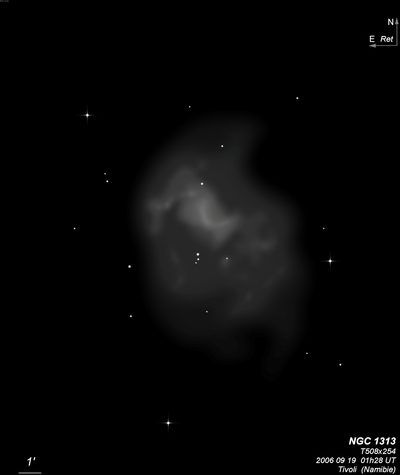
Just east of the north-northeast end of the main bar is [PES80] 1, another brighter HII knot, ~30"x15" and oriented E-W. A faint star (or stellar knot) is less than 1' NW. This bright HII region is embedded in a diffuse arm that curves gently east-southeast from the north end of the bar. After the bright knot, this extension dims but ends at [PES80] 3, a third bright knot ~15" diameter, which is isolated the end of this arm (nearly due east of the core). The HII designations are from the 1980 study by Page, Edmunds and Smith in MNRAS, 193, 219.
NGC 1313A = ESO 83-1, located 16' SE, appeared as a fairly small, thin edge-on oriented 4:1 SSW-NNE, ~0.6'x0.15'.
James Dunlop discovered NGC 1313 = D 206 = h2528 on 27 Sep 1826, describing "a faint ill-defined nebula, rather extended in the direction of the meridian, with several exceedingly minute stars in it." John Herschel only observed this bright galaxy on one sweep and logged "pB, irreg R or lE, vL, vgbM, resolvable, 3'."
Joseph Turner observed and sketched the galaxy on 13 Nov 1878 with the 48-inch Melbourne Telescope (p.194 of logbook). He sketched the central bar oriented N-S, broader on the south end and tapering on the east end. Just north of end of the "bar" he sketched a small knot, probably a HII region. A small elongated patch was seen just east of the north end of the bar, oriented NW-SE (part of the eastern spiral arm). A symmetric elongated patch was shown just west of the south end, also oriented NW-SE (this is the brightest section of the western arm).
Pietro Baracchi also observed the galaxy on 4 Dec 1885 and wrote, "pB, vL, irregular, pmbM,. This object is complicated. It seems to have appendages not quite detached from the main body but alomost separated from it by two very faint portions which seem at first void of nebula, giving a first impression of three detached nebulae, the middle of which is large, elongated due N and S and gpmbM and the other two, small very faint patches one north and one south of the middle one. The north one pretty much brighter than the south one - but these three individualities are connected by extremely fant nebulous intervals. Another extremely faint pretty large round flat object south-preceding [NGC 1313]. I believe this is a new nebula." His sketch includes this object as a diffuse patch labeled as "New?" on the southwest side. At his position is the HII complex [PES80] 8, which is situated between the central part of the galaxy and a mag 10 star 7.6' SW of center. [PES80] 1 is also shown on the sketch as a brighter patch on the NE end of the galaxy.
600/800mm - 24" (4/4/08 - Magellan Observatory, Australia): this was the first object I took a look at using the 24" f/3.7 as it was the brightest galaxy I had yet to observe. I was amazed to find a striking, two-armed barred spiral with obvious bright HII knots in the arms! At 200x the main body of the galaxy appeared as a bright oval or wide bar ~4.5'x3.5' oriented SSW-NNE with a central bulge. A relatively short spiral arm emerges from the south-southwest end and hooks towards the northwest. Embedded with this extension is [PES80] 5/6, a brighter elongated HII knot, ~30"x20". A mag 15 star is west of the northwest end of this arm.
Notes by Steve Gottlieb